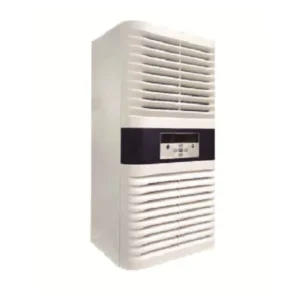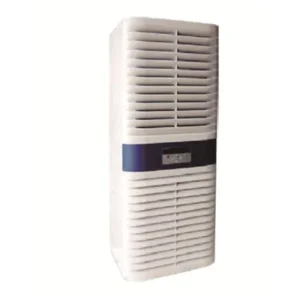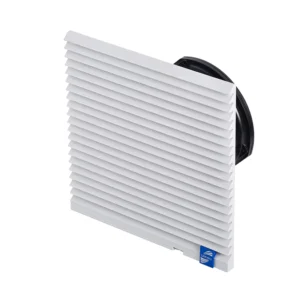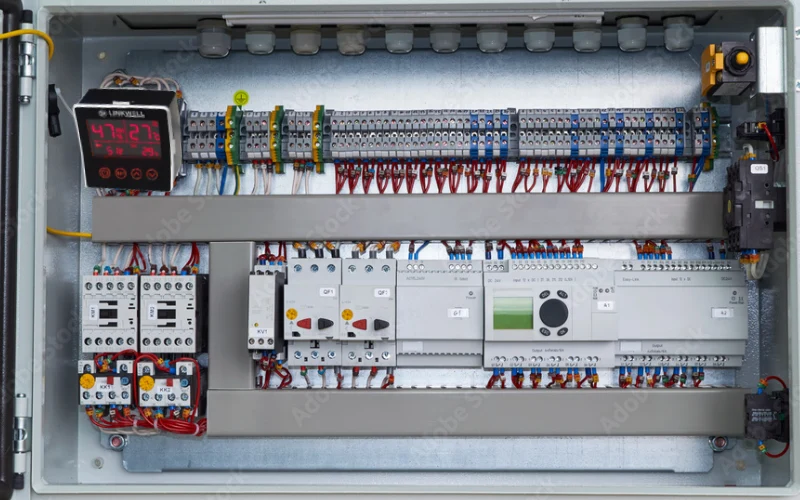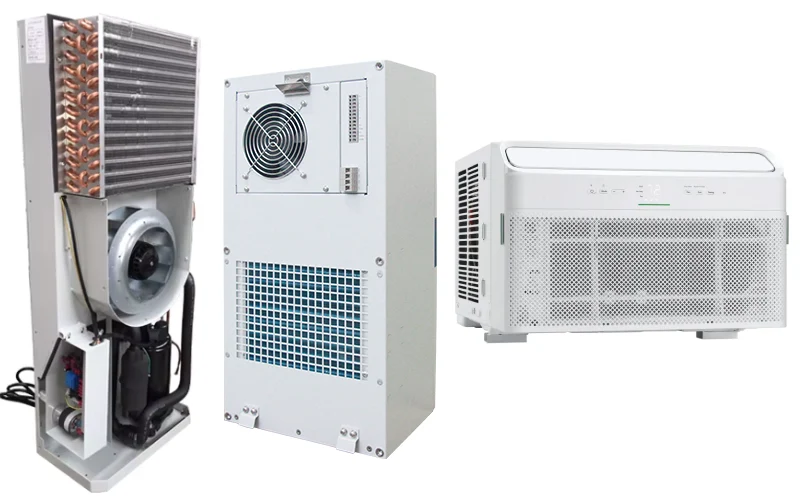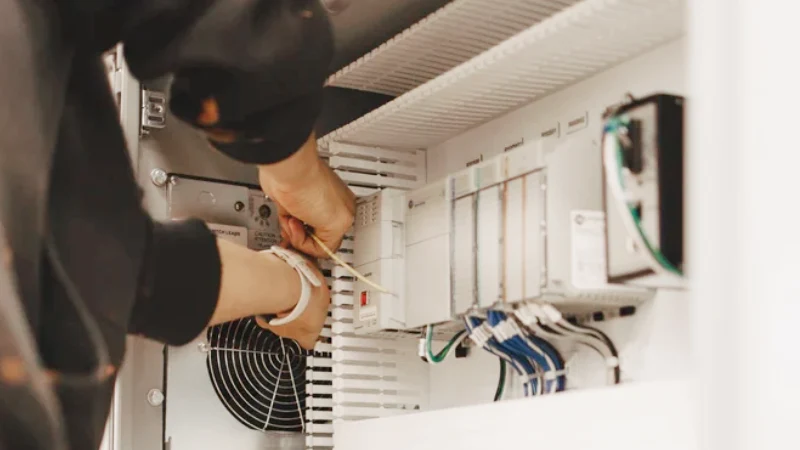Ever wondered how does air conditioning work? You get cool air because your unit pulls heat out of the space and sends it outside. This process uses a refrigeration cycle, which keeps your room or electrical cabinet comfortable and safe. Cabinet Air Conditioners, like those from Linkwell, use the same principle to protect sensitive equipment in factories and telecom boxes. The global air conditioning market keeps growing, with a projected size of USD 390.39 billion by 2033.

Key Takeaways
- Air conditioning cools by moving heat from inside a space to the outside using a refrigeration cycle with four main steps: compression, condensation, expansion, and evaporation.
- Key parts like the compressor, evaporator coil, condenser coil, expansion valve, and fans work together to keep equipment cool and safe in cabinets and enclosures.
- Regular maintenance, such as cleaning filters and coils and checking fans, keeps your air conditioner efficient and prevents equipment overheating.
- Using smart thermostats and digital controls helps you manage temperature precisely, save energy, and monitor your system remotely.
- Proper airflow and clean filters are vital to avoid hot spots and ensure steady cooling, especially in industrial and outdoor environments.
How Does Air Conditioning Work?
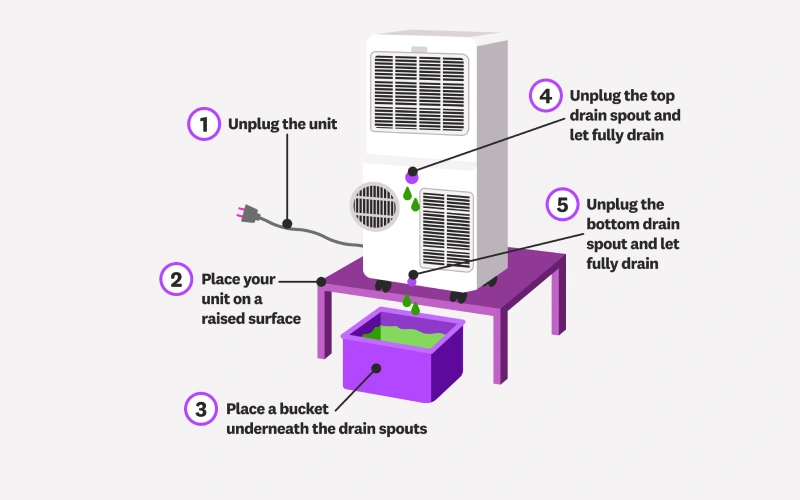
The Cooling Cycle
If you want to know how does air conditioning work, you need to understand the cooling cycle. This cycle is the heart of every air conditioner, including the Cabinet Air Conditioner you might find in a factory or telecom box. The process moves heat from inside the cabinet to the outside, keeping sensitive electronics safe and cool.
Let’s break down the steps:
- Compressor
The cycle starts with the compressor. It squeezes the refrigerant gas, making it hot and high-pressure. In a Cabinet Air Conditioner, this step happens inside a sealed unit, so the heat stays away from your electronics. - Condenser
Next, the hot gas travels to the condenser coil. Here, a fan blows outdoor air over the coil, and the refrigerant releases its heat to the outside. The gas cools down and turns into a liquid. This is how the Cabinet Air Conditioner pushes heat out of the enclosure. - Expansion Device
The liquid refrigerant passes through an expansion valve. This device drops the pressure quickly, making the refrigerant cold and ready to absorb heat again. - Evaporator
Now, the cold refrigerant enters the evaporator coil. Air from inside the cabinet flows over the coil. The refrigerant absorbs heat from the air, turning back into a gas. The cooled air keeps your equipment running smoothly.
Tip: The Cabinet Air Conditioner repeats this cycle over and over, so your electronics stay at a safe temperature even when the weather outside is hot or humid.
Key Components
You might wonder what parts make this process work. Every air conditioning system, especially a Cabinet Air Conditioner, relies on a few key components:
- Evaporator Coil
This coil sits inside the cabinet. It’s where the refrigerant absorbs heat from the air, cooling the space. - Compressor
The compressor is the powerhouse. It pumps the refrigerant through the system and keeps the cycle moving. - Condenser Coil
Located outside the cabinet, the condenser coil releases heat to the environment. A fan helps move air across the coil for better cooling. - Expansion Valve
This valve controls the flow of refrigerant, dropping its pressure and temperature before it enters the evaporator. - Fans
Fans move air over the coils and help distribute cool air inside the cabinet. - Digital Controls
Modern Cabinet Air Conditioners, like those from Linkwell, use smart controllers and sensors. You can set the temperature, monitor performance, and even get alerts if something goes wrong.
| Component | What It Does | Where You Find It |
|---|---|---|
| Evaporator Coil | Absorbs heat, cools air | Inside cabinet |
| Compressor | Pressurizes refrigerant, drives the cycle | Cabinet AC unit |
| Condenser Coil | Releases heat to outside air | Outside cabinet |
| Expansion Valve | Lowers pressure and temperature of refrigerant | Between condenser & evaporator |
| Fans | Move air over coils, distribute cool air | Inside & outside cabinet |
| Digital Controls | Manage temperature, monitor system | Control panel |
Linkwell Cabinet Air Conditioners use these components to keep battery cabinets, telecom boxes, and industrial control panels at the right temperature. You get reliable cooling, automatic protection, and easy remote monitoring. This is how does air conditioning work in tough industrial environments, making sure your equipment stays safe and efficient.
Air Intake & Filtration
Drawing in Warm Air
When you use a Cabinet Air Conditioner, the first step is to pull in the warm air from inside the enclosure. The indoor fan gets to work right away. It draws the warm air through return vents or ducts, making sure no hot spots are left behind. This process is similar to what happens in home air conditioning, but here, it protects sensitive electronics instead of people.
Here’s how it works in a typical Cabinet Air Conditioner:
- The blower fan pulls the warm air from inside the cabinet.
- The air moves through a vent and heads straight for the evaporator coil.
- As the air passes over the cold coil, the refrigerant inside absorbs the heat.
- The now-cooled air gets pushed back into the cabinet, keeping your equipment safe.
You can picture this as a loop. The fan keeps the air moving, so every part of the cabinet stays at a steady, cool temperature. This step is crucial for industrial and telecom applications, where even a small rise in temperature can cause problems for your electronics.
Tip: If you notice uneven cooling or hot spots in your cabinet, check the airflow. Good air movement is key to effective cooling.
Air Filter Role
Before the warm air reaches the evaporator coil, it passes through an air filter. This filter acts like a gatekeeper, catching dust, dirt, and other particles. In industrial settings, where cabinets often face dusty or harsh environments, a reliable filter is a must.
High-quality filters, like those used in Linkwell Cabinet Air Conditioners, can trap a large amount of airborne dust and allergens. Scientific studies show that HEPA filters remove up to 99.97% of tiny particles, while moderate-efficiency filters can cut fine dust by 80%. Even if your cabinet doesn’t need a HEPA filter, a good filter still keeps most dust and debris away from sensitive components.
Clean air means your electronics last longer and work better. You also reduce the risk of overheating, since dust buildup can block airflow and make cooling less effective. Regularly checking and replacing the filter helps your air conditioning system run smoothly and keeps your equipment protected.
Evaporator Coil Process
Heat Absorption
When you run a Cabinet Air Conditioner, the evaporator coil takes center stage in cooling. This coil sits inside the cabinet, right where the warm air flows. The indoor blower fan pulls the hot air from around your electronics and pushes it across the evaporator coil. Inside the coil, cold liquid refrigerant waits to do its job.
As the warm air touches the coil, something important happens. The refrigerant inside the evaporator coil absorbs the heat from the air. The coil’s copper tubes and fins help transfer as much heat as possible. You get cooler air blowing back into the cabinet, while the electronics stay safe from overheating. If you want your Cabinet Air Conditioner to work well, keep the coil clean. Dust or dirt can block the heat transfer, making the cooling less effective.
Tip: Regularly check and clean the evaporator coil in your Cabinet Air Conditioner. This simple step keeps your cooling system running strong and your equipment protected.
Refrigerant Change
The magic of cooling happens when the refrigerant changes state inside the evaporator coil. Here’s how it works:
- The refrigerant enters the evaporator coil as a cold, low-pressure liquid.
- As the warm air passes over the coil, the refrigerant absorbs heat.
- Because of its low boiling point, the refrigerant quickly turns from liquid to gas.
- This phase change—called evaporation—pulls heat out of the air, making the inside of your cabinet cooler.
- The refrigerant leaves the coil as a low-pressure gas, ready to move on to the next step in the cycle.
This process repeats over and over, keeping your sensitive electronics at a safe temperature. In industrial and telecom settings, a Cabinet Air Conditioner uses this reliable cycle to protect vital equipment, even when outside temperatures soar.
Compressor Function
Pressure Increase
The compressor acts as the heart of your Cabinet Air Conditioner. When warm air from inside the cabinet passes over the evaporator coil, the refrigerant inside absorbs heat and turns into a low-pressure gas. Now, the compressor steps in. It pulls this vaporized refrigerant from the evaporator and squeezes it tightly. This action raises both the pressure and temperature of the refrigerant gas.
You can think of the compressor like a powerful pump. It takes in the cool, low-pressure gas and compresses it into a hot, high-pressure vapor. This pressure increase is not just a technical detail—it’s a critical step. Without it, the refrigerant would not have enough energy to move through the rest of the system or release heat effectively. In a Cabinet Air Conditioner, this process happens inside a sealed unit, so your sensitive electronics stay protected from heat and humidity.
Note: The compressor’s job is essential. If it fails, the entire cooling cycle stops, and your equipment could overheat.
Preparing for Heat Release
Once the compressor has done its job, the refrigerant leaves as a hot, high-pressure gas. This is where the magic of heat removal begins. The compressor prepares the refrigerant for the next stage—releasing heat in the condenser coil.
Here’s what happens next:
- The high-pressure, high-temperature refrigerant travels to the condenser coil, usually located outside the cabinet.
- Because the refrigerant is now much hotter than the outdoor air, it can easily give up its heat.
- As the refrigerant moves through the condenser coil, a fan blows air across the coil, helping the refrigerant release its heat to the outside environment.
- The refrigerant cools down and changes back into a liquid, ready to start the cycle again.
This step is crucial for Cabinet Air Conditioners in industrial and telecom settings. By raising the refrigerant’s pressure and temperature, the compressor ensures that heat can flow out of the cabinet, keeping your electronics safe and your operations running smoothly.
Tip: Regular maintenance of the compressor helps your Cabinet Air Conditioner work efficiently and extends the life of your equipment.
Condenser Coil & Heat Release
Outdoor Heat Transfer
When you use a Cabinet Air Conditioner, the condenser coil becomes the main player in getting rid of unwanted heat. After the compressor sends out hot, high-pressure refrigerant gas, this gas flows into the condenser coil, which usually sits outside the cabinet. The coil, often made from copper or aluminum with lots of fins, gives the refrigerant a big surface area to release heat.
Here’s what happens next. The refrigerant enters the coil at a temperature higher than the outdoor air. As it moves through the coil, it starts to cool down. The magic happens when the refrigerant changes from a vapor to a liquid. This phase change releases a lot of heat, which the coil pushes out to the surrounding air. The temperature of the refrigerant stays almost the same during this process, so the heat transfer works at top efficiency. You can count on the condenser coil to remove the heat your Cabinet Air Conditioner pulled from inside, making sure your sensitive electronics stay cool and safe.
Tip: The condenser coil works best when it stays clean and has plenty of airflow. Dust or debris can block heat transfer and lower your cooling power.
Fan Operation
The outdoor fan is the unsung hero of your Cabinet Air Conditioner. You might not notice it, but this fan sits right by the condenser coil and keeps air moving across the coil’s surface. When the fan blows cooler outdoor air over the hot coil, it helps the refrigerant release its heat and turn back into a liquid. This step is essential for the air conditioning cycle to keep going.
Let’s break down why the fan matters:
- It keeps a steady flow of air over the condenser coil.
- It helps the refrigerant cool down and condense quickly.
- It prevents the compressor from overheating.
- It boosts the overall efficiency of your Cabinet Air Conditioner.
If the fan stops working, the system can’t get rid of heat fast enough. That means your electronics could overheat, and the whole cooling process slows down. Always check that the fan runs smoothly and stays free of dust or blockages.
Note: Proper fan operation is key for energy savings and reliable performance, especially in tough industrial or telecom environments where Cabinet Air Conditioners work around the clock.
Expansion Valve
Pressure Drop
The expansion valve in your Cabinet Air Conditioner plays a key role in the cooling cycle. You might think of it as a gatekeeper for the refrigerant. When the high-pressure liquid refrigerant leaves the condenser coil, it heads straight for the expansion valve. Here, the valve restricts the flow, causing a sudden drop in pressure. This pressure drop is not just a technical detail—it’s what makes cooling possible.
- The valve lowers the pressure of the refrigerant, letting it expand and partially evaporate.
- The refrigerant’s temperature drops quickly, so it enters the evaporator coil cold and ready to absorb heat.
- The valve uses a sensing bulb to monitor the temperature at the evaporator outlet, adjusting the flow for maximum efficiency.
- It keeps the refrigerant from flooding the coil or running too low, which could lead to lukewarm or hot air inside your cabinet.
| Function/Aspect | Explanation |
|---|---|
| Pressure reduction | The valve drops the refrigerant’s pressure, allowing it to expand and cool. |
| Temperature change | The refrigerant leaves the valve cold, ready to absorb heat. |
| Flow regulation | The valve adjusts flow based on evaporator temperature. |
| Superheat control | Maintains safe superheat to prevent liquid slugging. |
When you use a Cabinet Air Conditioner, this pressure drop lets the refrigerant evaporate at a lower temperature. The process absorbs heat from the air inside the cabinet, keeping your electronics safe and cool.
Cycle Restart
After the expansion valve does its job, the cooling cycle starts again. The cold, low-pressure refrigerant enters the evaporator coil. As air from inside the cabinet passes over the coil, the refrigerant absorbs heat and changes from liquid to vapor. This phase change is what cools the air and protects your sensitive equipment.
You get a continuous loop:
- The compressor pushes the refrigerant through the system.
- The condenser coil releases heat outside.
- The expansion valve drops the pressure and temperature.
- The evaporator coil absorbs heat from inside the cabinet.
Tip: If your Cabinet Air Conditioner isn’t cooling well, check the expansion valve. A clogged or faulty valve can disrupt the cycle and leave your equipment at risk.
The expansion valve keeps the cooling cycle running smoothly. You get reliable temperature control, efficient heat absorption, and steady protection for your electronics. In industrial and telecom settings, this step is vital for keeping operations safe and equipment running strong.
Air Distribution
Blower Fan
The blower fan in your Cabinet Air Conditioner does more than just move air—it’s the driving force behind even cooling. When you turn on your unit, the blower fan pulls warm air from inside the cabinet and pushes it across the evaporator coil. This process cools the air before sending it back into the enclosure. You get steady, reliable airflow that keeps every corner of your cabinet at a safe temperature.
Here’s how the blower fan distributes cooled air effectively:
- You position the blower fan coil in a spot that avoids corners or blocked areas, so air reaches everywhere.
- You mount the unit securely, which cuts down on vibration and noise.
- You align the ductwork with the blower, making sure air flows smoothly without leaks.
- You use diffusers and grilles to direct the airflow, so you don’t get cold or hot spots.
- You connect the electrical system safely, so the fan runs efficiently.
Tip: In large cabinets or enclosures, you can adjust the blower fan speed to match your cooling needs. This helps save energy and keeps your equipment comfortable.
Blower fans come in different styles—horizontal, vertical, or ceiling-mounted—so you can fit them into any cabinet layout. In Linkwell Cabinet Air Conditioners, the blower fan works with smart controls to keep airflow steady, even if the temperature outside changes.
Ductwork
Ductwork acts like the highway for cooled air inside your Cabinet Air Conditioner. It carries the air from the blower fan to every part of the enclosure, making sure no spot gets left out. If you design the ductwork well, you get balanced airflow and consistent temperatures.
- Ductwork circulates cooled air, keeping the whole cabinet comfortable.
- Proper sizing and sealing stop leaks and prevent energy waste.
- Insulated ducts help maintain the right temperature, even in hot or cold environments.
- Registers and grilles direct air exactly where you need it.
- Zoning systems with dampers let you control airflow to different sections, so you can customize cooling for sensitive equipment.
If you ignore ductwork, you might see uneven temperatures or higher energy bills. Well-designed ductwork in your Cabinet Air Conditioner means your electronics stay safe, your system runs efficiently, and you avoid costly downtime. Regular checks and maintenance keep everything working at its best.
System Control
Thermostat
You control the temperature inside your Cabinet Air Conditioner with a thermostat. This device acts like the brain of your cooling system. It keeps track of the temperature inside the cabinet and tells the air conditioner when to turn on or off. You set your preferred temperature, and the thermostat does the rest.
- The thermostat checks the air temperature using sensors.
- If the cabinet gets too warm, it signals the air conditioner to start cooling.
- When the temperature drops to your set point, it shuts the system off to save energy.
- Mechanical thermostats use simple parts, like metal strips, to sense changes.
- Digital thermostats use electronic sensors for more accurate control.
Modern thermostats do more than just switch the air conditioner on and off. You can program them to follow a schedule, so your equipment stays cool only when needed. Smart thermostats even learn your habits and adjust settings automatically. You get better comfort, lower energy bills, and longer life for your Cabinet Air Conditioner.
Tip: If you want to save energy, set your thermostat to match your equipment’s working hours. This way, your Cabinet Air Conditioner runs only when necessary.
Digital Controls
Digital controls take your Cabinet Air Conditioner to the next level. You get precise temperature management, easy monitoring, and smart features that make cooling simple. Linkwell’s cabinet air conditioners come with advanced digital controllers that let you set exact temperatures, check system status, and receive alerts if something goes wrong.
- You can adjust settings from a control panel or even remotely using a smartphone.
- Digital controllers use sensors to keep the temperature steady, avoiding big swings.
- Smart features include alarms for high temperature, filter reminders, and energy usage reports.
- Some models support Modbus or other protocols for integration with building management systems.
- You can schedule cooling times, manage multiple zones, and track performance in real time.
With digital controls, you get more than just basic cooling. You enjoy peace of mind, knowing your sensitive electronics stay safe. Linkwell’s smart controllers help you optimize energy use, reduce downtime, and keep your industrial or telecom cabinets running smoothly.
Note: Upgrading to digital controls means you spend less time worrying about temperature and more time focusing on your work.
Applications in Industry
Recommended products
Cabinet Air Conditioner Use
You see cabinet air conditioners working hard in factories, power plants, and telecom stations. These units cool machinery control panels, motor control centers, and other vital equipment. When you use a cabinet air conditioner, you protect your electronics from overheating and keep your operations running smoothly. Linkwell’s cabinet air conditioners stand out because they use advanced refrigeration technology and closed-loop cooling systems. You get precise temperature control, which means your sensitive telecom components stay safe from dust, humidity, and external heat.
- You benefit from optimized heat dissipation, so your equipment stays at the right temperature even during heavy use.
- Energy-saving operation helps you cut power costs while maintaining strong cooling performance.
- Stable climate control inside the cabinet extends the life of your electronics and prevents failures.
- You can choose from flexible mounting options and modular designs, making installation easy.
- Smart control interfaces let you monitor and adjust settings remotely, so you always know your system is working.
If you work in a dusty or harsh environment, the closed-loop design keeps outside air out, protecting your electronics from contamination.
Outdoor Enclosure Cooling
Outdoor enclosures need reliable cooling to protect critical systems from heat, dust, and weather. Linkwell’s outdoor enclosure solutions use smart fans and thermostats that activate only when temperatures rise. You get cooling when you need it, which saves energy and keeps your equipment safe. The closed-loop cooling technology seals the enclosure, preventing outside air and dust from getting in. This design boosts cooling efficiency and reduces energy waste.
- Smart speed-adjustable fans provide cooling on demand, so you don’t waste power.
- DC fans save up to 30% more energy compared to traditional AC fans.
- PWM speed adjustment responds quickly to temperature changes, making your system more efficient.
You can rely on Linkwell’s outdoor enclosures for durability and continuous operation, even in tough climates. These solutions help you avoid downtime and keep your network or factory running strong.
| Feature | Benefit |
|---|---|
| Thermostat-activated fan | Cools only when needed, saves energy |
| Sealed enclosure | Keeps dust and contaminants out |
| Speed-adjustable fans | Delivers efficient, targeted cooling |
You get peace of mind knowing your equipment is protected and your air conditioning system works efficiently.
Efficiency & Care
Maintenance Tips
Keeping your Cabinet Air Conditioner in top shape helps you avoid breakdowns and keeps your equipment safe. You don’t need to be an expert to handle basic care. Here’s a simple checklist you can follow:
- Replace air filters every 1 to 3 months. This keeps airflow strong and protects your electronics from dust.
- Clean the evaporator coil with a soft brush and coil cleaner. Dirt buildup can block cooling, so check it regularly.
- Flush the condensate drain line. Use a mix of bleach and water or a wet/dry vacuum to keep it clear and prevent mold.
- Keep the outdoor unit free of debris. Remove leaves, sticks, and dirt so your Cabinet Air Conditioner can release heat easily.
- Straighten and clean the condenser fins. Bent fins block airflow. Use a fin comb or gentle brush.
- Check that the outdoor unit sits level. A stable base prevents strain on pipes and wiring.
- Inspect fan blades and replace if damaged. Smooth fan operation means better cooling.
Tip: Regular maintenance can save you between 5% and 15% on your annual energy bills. Clean filters and coils help your Cabinet Air Conditioner run efficiently and last longer.
Energy Saving
You can cut energy costs and boost the performance of your Cabinet Air Conditioner with a few smart habits:
- Set your thermostat a few degrees higher in summer. This reduces the workload on your AC.
- Use programmable or smart thermostats. These let you control cooling schedules and avoid running the unit when it’s not needed.
- Seal air leaks around doors, windows, and ducts. This keeps cool air inside your cabinet or enclosure.
- Plant shrubs or trees to shade outdoor units. Shade lowers the temperature around your Cabinet Air Conditioner and helps it work less.
- Use window blinds or curtains in nearby rooms to block out heat from the sun.
- Schedule professional inspections before peak seasons. A technician can spot problems early and keep your system running smoothly.
Keeping up with these tips means your Cabinet Air Conditioner will protect your sensitive equipment while saving you money and energy.
You’ve seen how does air conditioning work step by step, with the Cabinet Air Conditioner showing each part in action. Every component—compressor, evaporator, condenser, expansion valve, and fans—plays a vital role in keeping your sensitive equipment cool and safe. Linkwell’s air conditioning solutions stand out with certifications, corrosion-resistant materials, and smart controls, so you get reliable cooling in tough environments.
- Regular maintenance gives you:
- Better energy efficiency
- Fewer breakdowns
- Longer system life
- Safer operation
Keep your Cabinet Air Conditioner clean and inspected. You’ll enjoy steady performance and peace of mind.
FAQ
How often should you clean the air filter in your Cabinet Air Conditioner?
You should check and clean the air filter every month if your cabinet sits in a dusty area. In cleaner spaces, every three months works. Clean filters help your air conditioner run smoothly and protect your electronics.
Tip: Set a reminder so you never forget!
Can you use a Cabinet Air Conditioner outdoors?
Yes, you can! Linkwell Cabinet Air Conditioners come with weatherproof designs. You get reliable cooling for outdoor telecom boxes and industrial enclosures. These units keep dust, rain, and heat away from your sensitive equipment.
| Model Feature | Outdoor Use |
|---|---|
| IP65 Rating | ✅ |
| Sealed Design | ✅ |
What happens if your Cabinet Air Conditioner stops cooling?
If your unit stops cooling, check the power supply first. Look at the air filter and coils for dirt. Make sure the fan runs. If you still have trouble, call a technician. Quick action keeps your equipment safe.
Do Cabinet Air Conditioners save energy?
Absolutely! You get energy savings with inverter compressors and smart controls. Linkwell units adjust cooling based on temperature, so you use less power. Efficient cooling means lower bills and longer equipment life.
How do you control the temperature in a Cabinet Air Conditioner?
You set the temperature using a digital thermostat or smart controller. Linkwell Cabinet Air Conditioners let you adjust settings easily. You can monitor performance and get alerts if something goes wrong.
What does “Btu” mean in an air conditioner model?
Btu stands for British Thermal Unit. In the context of air conditioners, “Btu/h” (often shortened to just “Btu”) is a unit that measures the cooling or heating capacity of an AC unit. It represents the amount of heat the air conditioner can remove from or add to a room per hour. A higher number indicates a greater cooling or heating capacity. 6000 Btu/h ≈ 1.76 kW
Conclusion
Understanding How Does Air Conditioning Work is vital for making the right investment in cooling solutions. By learning the working principles, buyers can evaluate performance, energy efficiency, and long-term reliability. At Linkwellelectrics, we provide expert guidance, certified quality, and customized cooling systems that protect your equipment.
Contact us today for tailored solutions, competitive pricing, and fast delivery—your trusted partner for reliable air conditioning technology.

